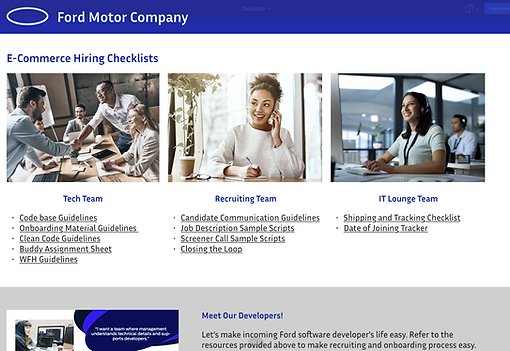Background:
The Ford e-commerce team is grappling with a growing issues with hiring and onboarding quality software engineers.
Solution:
Streamlined onboarding processes by designing a comprehensive checklist based on user journey and coordinated with various teams to resolve key blockers such as hardware delays.
My Role:
UX Researcher, UI Designer. Collaborated with SMEs from recruiting, marketing, project managers, software engineers, tech leaders, internal stakeholders, etc.
Pain Points:
-
Recruitment process was not optimized for the changing, post-pandemic job market.
-
Hardware/shipping delays and access issues hindering early progress.
Duration:
4 Months
Success:
-
Time-to-productivity for new developers reduced to 4 days.
-
Time to extend verbal offer to candidates reduced to 1-7 days.
-
83% candidates liked the new interview method we created.
*To comply with my non-disclosure agreement, I have obfuscated & redacted confidential information in this case study.
Legacy Process Bottlenecks
The e-commerce team is grappling with a growing backlog. In a post-pandemic job market, attracting and keeping skilled developers who adhere to clean coding principles is a struggle. The existing onboarding process is a patchwork of ad-hoc tasks, not optimized for remote work and fully online hiring process.
Pain Points:
-
Long time-to-productivity for new developers.
-
Hardware/shipping delays and access issues hindering early progress.
-
Recruitment process was not optimized for fully remote candidates and for a post-pandemic job market with more demand than supply .

Fig. Some insights from the exploratory User Research
Action:
-
Understanding Team Hiring Requirements: Initiated stakeholder reviews through detailed interviews with existing developers, project managers, and HR to understand the specific skills, cultural fit, and clean coding expectations required for the e-commerce development role.

Fig. Process flow map after several iteration
Ambiguity?
Persona to the Rescue!
Team consists of members from various backgrounds. There is confusion about how to start building a solution.
Action:
-
Persona Development: Leveraged subject matter expert knowledge to create initial proto persona, outlining typical backgrounds, motivations, and challenges. Iterated it throughout the research phase an developed in to Primary and Secondar persona.
-
User Interviews: Conducted user interviews with both existing and newly hired developers to understand their onboarding experiences, pain points, and suggestions for improvement. These interviews led to revisions of the initial personas, making them more accurate.
-
Tapping in to the pool of SMEs: Interviewed hiring managers and tech leads to understand the interview process, the experience provided to candidates, and their expectations from new hires.
-
Suggested Improvements: Using the data gathered from the interviews, suggested improvement areas were identified. These areas included hardware procurement, access provisioning, code guidelines, and performance tracking.

Fig. Primary Persona

Fig. Secondary Persona
Process:
-
Began mapping the current onboarding customer journey, identifying key touchpoints and potential bottlenecks.
-
Utilized estimated timelines for each stage to pinpoint areas of delay.
-
Iteratively refined the customer journey map based on feedback and observations.

Fig. User journey based on input from qualitative data capturing
the onboarding Checklist
Armed with a comprehensive understanding of the developer's journey, the focus shifted to designing a streamlined onboarding process.
Action:
Throughout iterations of interview, customer journey mapping with areas of improvement, developed final checklist:
-
E-commerce Tech Teams:
-
Simplification of codebase for easy comprehension by new developers
-
Project-specific onboarding material, FAQs, etc.
-
Integrated clean coding best practices into the onboarding process, providing resources and mentorship
-
Team Buddy assignment (especially for fully remote candidates)
-
Active WebEx team/Slack channels for natural communication for WFH and remote employees.
-
-
Recruiting:
-
Writing job description by closely collaborating with hiring manager/tech anchor.
-
Following preapproved interview scripts.
-
Proactively communicate with candidates.
-
-
Hardware Team:
-
Employee laptop should be assigned and shipped before start date.
-

Fig. Effort v Impact mapping to decide which findings to include in the checklist

At the end of the process improvement, I quickly set up an internal website using a custom website generation tool that provided an easy way for all the relevant teams to access the resources we had generated or collected throughout the process.
Fig. Clean Code Onboarding Checklist was provided on an internal website.
Outcome
Outcome Noted in Final Round of Data Capturing in Sept 2022:
-
Time-to-productivity for new developers: Reduced from two weeks to avg. 4 days.
-
Improved code quality and maintainability: Multi-factor metrics based on qualitative SME feedback.
-
Enhanced developer satisfaction: Multi-factor metrics based on quantitative user feedback.

Fig. Additional insights from the data captured a few weeks after we implemented the Process Improvement efforts.

